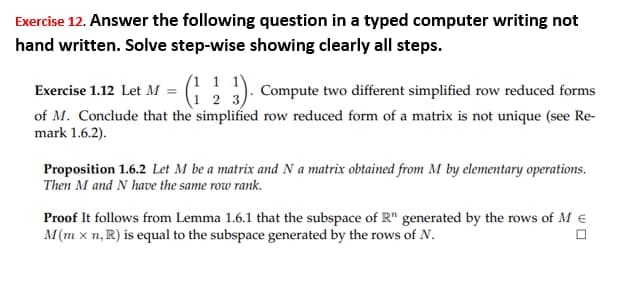Exercise 1.12 Let M (23). Compute two different simplified row reduced forms of M. Conclude that the simplified row reduced form of a matrix is not unique (see Re- mark 1.6.2).
Exercise 1.12 Let M (23). Compute two different simplified row reduced forms of M. Conclude that the simplified row reduced form of a matrix is not unique (see Re- mark 1.6.2).
Linear Algebra: A Modern Introduction
4th Edition
ISBN:9781285463247
Author:David Poole
Publisher:David Poole
Chapter3: Matrices
Section3.1: Matrix Operations
Problem 40EQ: In each of the following, find the 66matrixA=[aij] that satisfies the given condition:...
Related questions
Question

Transcribed Image Text:Exercise 12. Answer the following question in a typed computer writing not
hand written. Solve step-wise showing clearly all steps.
Exercise 1.12 Let M = (123). Compute two different simplified row reduced forms
of M. Conclude that the simplified row reduced form of a matrix is not unique (see Re-
mark 1.6.2).
Proposition 1.6.2 Let M be a matrix and N a matrix obtained from M by elementary operations.
Then M and N have the same row rank.
Proof It follows from Lemma 1.6.1 that the subspace of R" generated by the rows of M €
M(mx n, R) is equal to the subspace generated by the rows of N.
Expert Solution
This question has been solved!
Explore an expertly crafted, step-by-step solution for a thorough understanding of key concepts.
Step by step
Solved in 3 steps with 1 images

Recommended textbooks for you

Linear Algebra: A Modern Introduction
Algebra
ISBN:
9781285463247
Author:
David Poole
Publisher:
Cengage Learning

Elementary Linear Algebra (MindTap Course List)
Algebra
ISBN:
9781305658004
Author:
Ron Larson
Publisher:
Cengage Learning

Algebra & Trigonometry with Analytic Geometry
Algebra
ISBN:
9781133382119
Author:
Swokowski
Publisher:
Cengage

Linear Algebra: A Modern Introduction
Algebra
ISBN:
9781285463247
Author:
David Poole
Publisher:
Cengage Learning

Elementary Linear Algebra (MindTap Course List)
Algebra
ISBN:
9781305658004
Author:
Ron Larson
Publisher:
Cengage Learning

Algebra & Trigonometry with Analytic Geometry
Algebra
ISBN:
9781133382119
Author:
Swokowski
Publisher:
Cengage